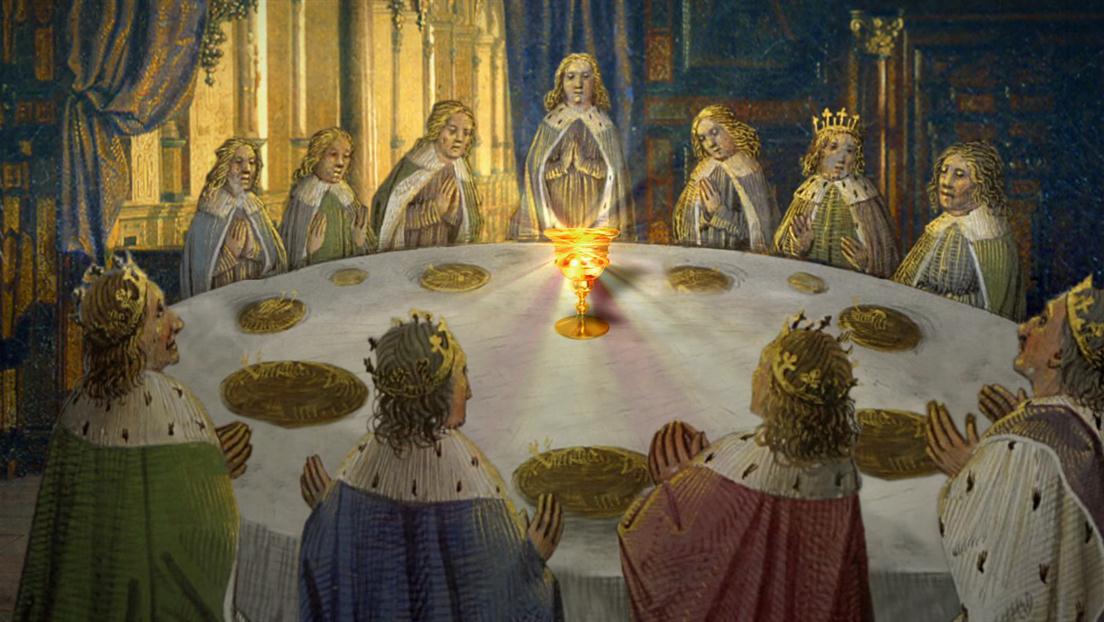 | ||
The Holy Grail is a vessel that serves as an important motif in Arthurian literature. Different traditions describe it as a cup, dish or stone with miraculous powers that provide happiness, eternal youth or sustenance in infinite abundance.
Contents
- Etymology
- Medieval literature
- Chrtien de Troyes
- Robert de Boron
- Other early literature
- Scholarly hypotheses
- Arts and literature
- Pseudohistory and popular culture
- References
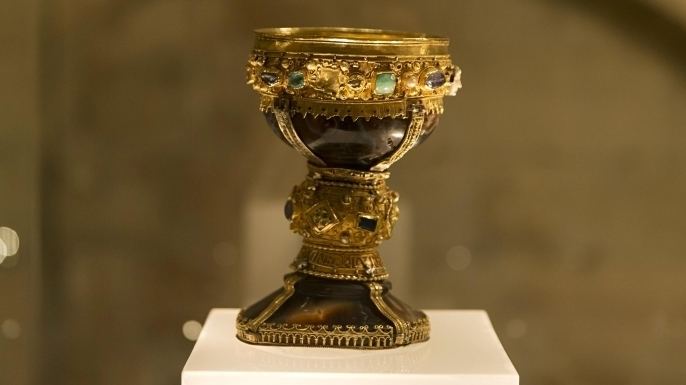
A "grail", wondrous but not explicitly holy, first appears in Perceval, le Conte du Graal, an unfinished romance written by Chrétien de Troyes around 1190. Here, it is a processional salver used to serve at a feast. Chrétien's story attracted many continuators, translators and interpreters in the later 12th and early 13th centuries, including Wolfram von Eschenbach, who perceived the grail as a great precious stone that fell from the sky. In the late 12th century, Robert de Boron wrote in Joseph d'Arimathie that the Grail was Jesus's vessel from the Last Supper, which Joseph of Arimathea used to catch Christ's blood at the Crucifixion. Thereafter, the Holy Grail became interwoven with the legend of the Holy Chalice, the Last Supper cup, a theme continued in works such as the Vulgate Cycle, the Post-Vulgate Cycle, and Thomas Malory's Le Morte d'Arthur

Scholars have long speculated on the origins of the Holy Grail before Chrétien, suggesting that it may contain elements of the trope of magical cauldrons from Celtic mythology combined with Christian legend surrounding the Eucharist.
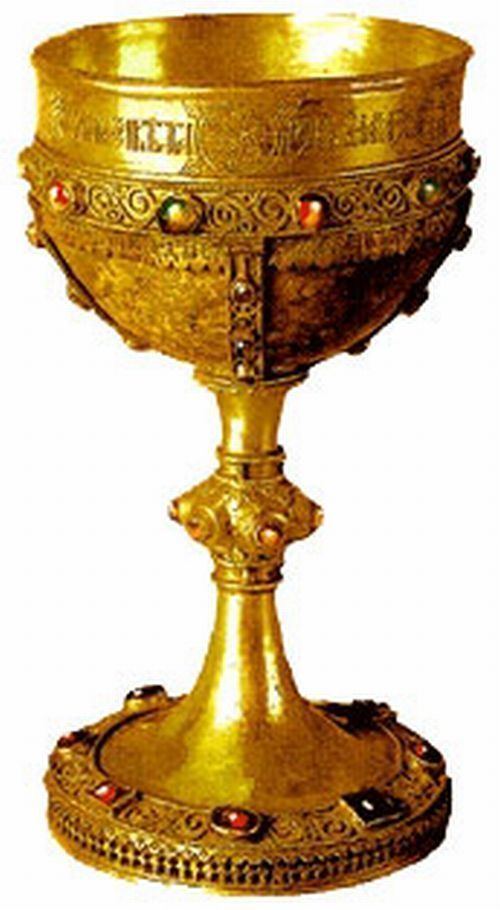
Etymology
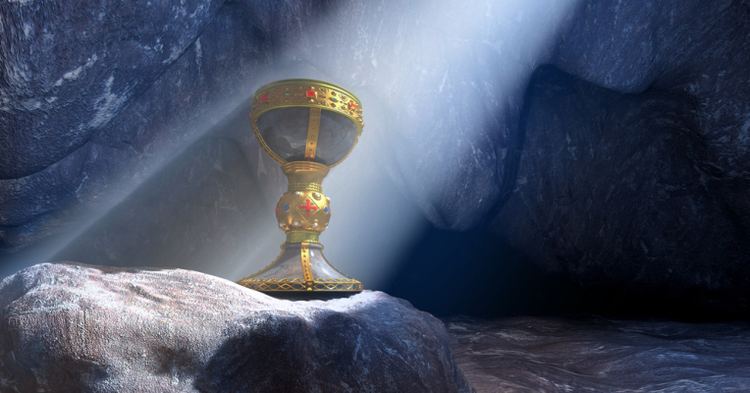
The word graal, as it is earliest spelled, comes from Old French graal or greal, cognate with Old Provençal grazal and Old Catalan gresal, meaning "a cup or bowl of earth, wood, or metal" (or other various types of vessels in different Occitan dialects). The most commonly accepted etymology derives it from Latin gradalis or gradale via an earlier form, cratalis, a derivative of crater or cratus, which was, in turn, borrowed from Greek krater (κρατήρ, a large wine-mixing vessel). Alternative suggestions include a derivative of cratis, a name for a type of woven basket that came to refer to a dish, or a derivative of Latin gradus meaning "'by degree', 'by stages', applied to a dish brought to the table in different stages or services during a meal".
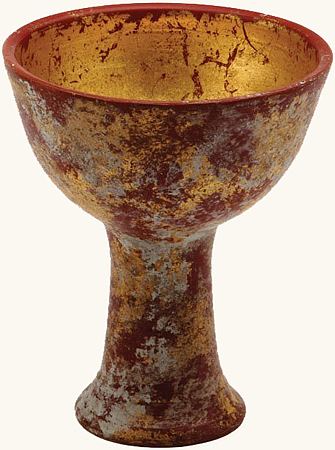
Late medieval writers came up with an alternative etymology for sangréal. In Old French, san graal or san gréal means "Holy Grail" and sang réal means "royal blood". According to the Catholic Encyclopedia this is a false etymology. After the cycle of Grail romances was well established, later writers used this alternative etymology. Since then, "Sang real" is sometimes employed to lend a medievalising air in referring to the Holy Grail. This connection with royal blood bore fruit in a modern bestseller linking many historical conspiracy theories (see below).
Medieval literature
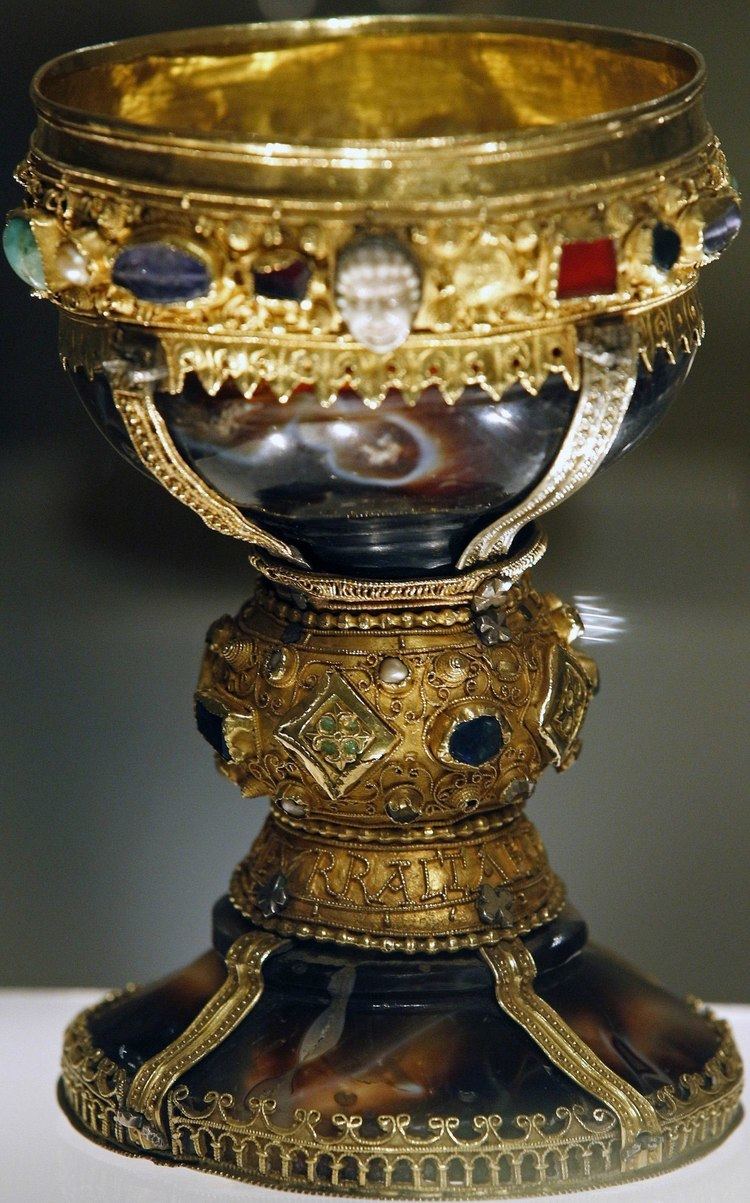
The Grail was considered a bowl or dish when first described by Chrétien de Troyes. Hélinand of Froidmont described a grail as a "wide and deep saucer" (scutella lata et aliquantulum profunda); other authors had their own ideas. Robert de Boron portrayed it as the vessel of the Last Supper. The Welsh romance Peredur had no Grail per se, presenting the hero instead with a platter containing his kinsman's bloody, severed head.
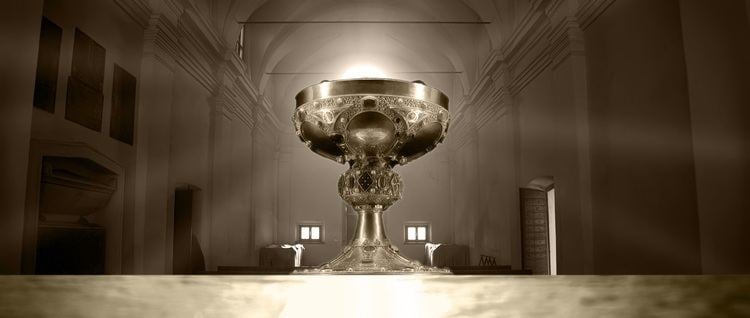
In Parzival, Wolfram von Eschenbach, citing the authority of a certain (probably fictional) Kyot the Provençal, claimed the Grail was a stone (called lapis exillis) that fell from Heaven, and had been the sanctuary of the neutral angels who took neither side during Lucifer's rebellion. The authors of the Vulgate Cycle used the Grail as a symbol of divine grace. Galahad, illegitimate son of Lancelot and Elaine, the world's greatest knight and the Grail Bearer at the castle of Corbenic, is destined to achieve the Grail, his spiritual purity making him a greater warrior than even his illustrious father. Galahad and the interpretation of the Grail involving him were picked up in the 15th century by Sir Thomas Malory in Le Morte d'Arthur and remain popular today.
Chrétien de Troyes
The Grail is first featured in Perceval, le Conte du Graal (The Story of the Grail) by Chrétien de Troyes, who claims he was working from a source book given to him by his patron, Count Philip of Flanders. In this incomplete poem, dated sometime between 1180 and 1191, the object has not yet acquired the implications of holiness it would have in later works. While dining in the magical abode of the Fisher King, Perceval witnesses a wondrous procession in which youths carry magnificent objects from one chamber to another, passing before him at each course of the meal. First comes a young man carrying a bleeding lance, then two boys carrying candelabras. Finally, a beautiful young girl emerges bearing an elaborately decorated graal, or "grail".
Chrétien refers to this object not as "The Grail" but as "a grail" (un graal), showing the word was used, in its earliest literary context, as a common noun. For Chrétien a grail was a wide, somewhat deep dish or bowl, interesting because it contained not a pike, salmon, or lamprey, as the audience may have expected for such a container, but a single Mass wafer which provided sustenance for the Fisher King's crippled father. Perceval, who had been warned against talking too much, remains silent through all of this and wakes up the next morning alone. He later learns that if he had asked the appropriate questions about what he saw, he would have healed his maimed host, much to his honour. The story of the Wounded King's mystical fasting is not unique; several saints were said to have lived without food besides communion, for instance Saint Catherine of Genoa. This may imply that Chrétien intended the Mass wafer to be the significant part of the ritual, and the Grail to be a mere prop.
Robert de Boron
Though Chrétien's account is the earliest and most influential of all Grail texts, it was in the work of Robert de Boron that the Grail truly became the "Holy Grail" and assumed the form most familiar to modern readers. In his verse romance Joseph d'Arimathie, composed between 1191 and 1202, Robert tells the story of Joseph of Arimathea acquiring the chalice of the Last Supper to collect Christ's blood upon his removal from the cross. Joseph is thrown in prison, where Christ visits him and explains the mysteries of the blessed cup. Upon his release Joseph gathers his in-laws and other followers and travels to the west, and founds a dynasty of Grail keepers that eventually includes Perceval.
Other early literature
After this point, Grail literature divides into two classes. The first concerns King Arthur's knights visiting the Grail castle or questing after the object. The second concerns the Grail's history in the time of Joseph of Arimathea.
The nine most important works from the first group are:
Of the second class there are:
In Wolfram von Eschenbach's telling, the Grail was kept safe at the castle of Munsalvaesche (mons salvationis), entrusted to Titurel, the first Grail King. Some, not least the Benedictine monks of Montserrat, have identified the castle with the real sanctuary of Montserrat in Catalonia.
Scholarly hypotheses
There has been some debate regarding the question whether the "origin" of the Grail legend should be seen as deriving from "Celtic mythology". This view was championed by Roger Sherman Loomis, Alfred Nutt and Jessie Weston. Loomis traced a number of parallels between Medieval Welsh literature and Irish material and the Grail romances, including similarities between the Mabinogion's Bran the Blessed and the Arthurian Fisher King, and between Bran's life-restoring cauldron and the Grail.
The opposing view dismissed the "Celtic" connections as spurious and interpreted the legend as essentially Christian in origin. Joseph Goering of the University of Toronto has identified sources for Grail imagery in 12th century wall paintings from churches in the Catalan Pyrenees (now mostly removed to the Museu Nacional d'Art de Catalunya, Barcelona, Spain), which present unique iconic images of the Virgin Mary holding a bowl that radiates tongues of fire, images that predate the first literary account by Chrétien de Troyes. Goering argues that they were the original inspiration for the Grail legend.
Barber (2004) argued that the Grail legend is connected to the introduction of "more ceremony and mysticism" surrounding the sacrament of the Eucharist in the high medieval period, proposing that the first Grail stories may have been connected to the "renewal in this traditional sacrament".
Scavone (1999, 2003) has argued that the "Grail" in origin referred to the Shroud of Turin.
Psychologists Emma Jung and Marie-Louise von Franz used analytical psychology to interpret the Grail as a series of symbols in their book The Grail Legend. This expanded on interpretations by Carl Jung, which were later invoked by Joseph Campbell.
In 2016, Goulven Peron suggested that the Holy Grail may reflect the horn of the river-god Achelous as described by Ovid in the Metamorphoses.
Arts and literature
The story of the Grail and of the quest to find it became increasingly popular in the 19th century, referred to in literature such as Alfred, Lord Tennyson's Arthurian cycle the Idylls of the King. A sexualised interpretation of the grail, now identified with female genitalia, appeared in 1870 in Hargrave Jennings' book The Rosicrucians, Their Rites and Mysteries. The combination of hushed reverence, chromatic harmonies and sexualized imagery in Richard Wagner's late opera Parsifal, premiered in 1882, developed this theme, associating the grail – now periodically producing blood – directly with female fertility. The high seriousness of the subject was also epitomized in Dante Gabriel Rossetti's painting (illustrated), in which a woman modeled by Alexa Wilding holds the Grail with one hand, while adopting a gesture of blessing with the other.
A major mural series depicting the Quest for the Holy Grail was done by the artist Edwin Austin Abbey during the first decade of the 20th century for the Boston Public Library. Other artists, including George Frederic Watts and William Dyce, also portrayed grail subjects.
The Grail later appeared in films; it debuted in a silent Parsifal. In The Light of Faith (1922), Lon Chaney attempted to steal it. The Silver Chalice, a novel about the Grail by Thomas B. Costain, was made into a 1954 film. Lancelot du Lac (1974) was made by Robert Bresson. Monty Python and the Holy Grail (1975) (adapted in 2004 as the stage production Spamalot) was a comedic adaptation. John Boorman, in his film Excalibur, attempted to restore a more traditional heroic representation of an Arthurian tale, in which the Grail is revealed as a mystical means to revitalise Arthur and the barren land to which his depressive sickness is connected. Indiana Jones and the Last Crusade and The Fisher King are more recent adaptations.
The Grail has been used as a theme in fantasy, historical fiction and science fiction; a quest for the Grail appears in Bernard Cornwell's series of books The Grail Quest, set during the Hundred Years War. Michael Moorcock's fantasy novel The War Hound and the World's Pain depicts a supernatural Grail quest set in the era of the Thirty Years' War. It is also a central theme in the Stargate SG-1 (season 10) episode "the Quest".
The grail is central in many modern Arthurian works, including Charles Williams's novel War in Heaven and his two collections of poems about Taliessin, Taliessin Through Logres and Region of the Summer Stars, and in feminist author Rosalind Miles' Child of the Holy Grail. Marion Zimmer Bradley's The Mists of Avalon presented the Grail as a symbol of water, part of a set of objects representing the four classical elements. The Grail also features heavily in Umberto Eco's 2000 novel Baudolino. and Robert B. Gregg's 2016 releases King Arthur & The Holy Grail, and The Holy Grail: More than a Legend, both published by Avalon House Classics.
Pseudohistory and popular culture
The Grail legend was incorporated with the "Priory of Sion" hoax and popularised in the 1982 Holy Blood, Holy Grail. The narrative developed here is that Jesus survived the cross to father children with Mary Magdalene whose descendants founded the Merovingian dynasty. The "Grail" is taken as a reference to Mary Magdalene and the Merovingian lineage as the "receptacle" of Jesus' bloodline (playing on the sang real etymology). While the 1982 publication was ostensibly intended as non-fiction, the ideas presented became a popular topic in popular culture with Dan Brown's The Da Vinci Code (2003). In Brown's novel, it is hinted that this Grail was long buried beneath Rosslyn Chapel in Scotland, but that in recent decades its guardians had it moved to a secret chamber embedded in the floor beneath the Inverted Pyramid in the entrance of the Louvre museum.
In the 1989 film Indiana Jones and the Last Crusade, the titular hero/archeologist races to find the Holy Grail against German Nazis in 1938.
In The Sign and the Seal (1992), Graham Hancock asserts that the Grail story is a coded description of the Ark of the Covenant.
In "Fate/stay night", gives a single wish to whom ever wins the battle royal.
